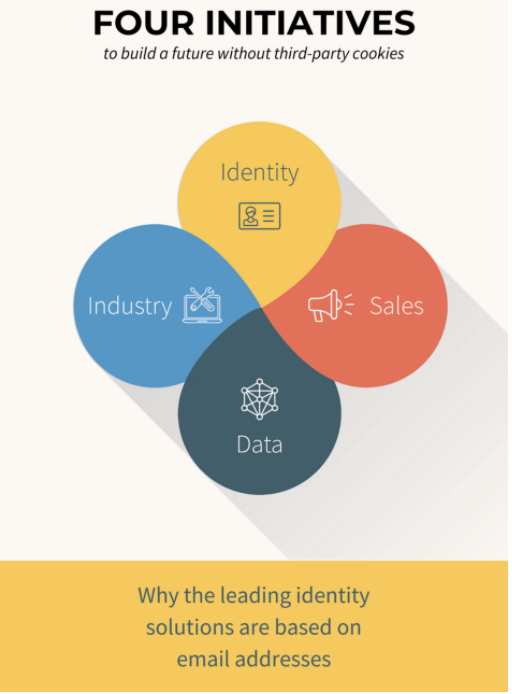Why the leading identity solutions are based on email addresses
When we share our approach to identity as one of CafeMedia’s initiatives to build a future without third-party cookies, it sparks a lot of questions centered around email… Why are we so focused on email-based identity? What about publishers who...

When we share our approach to identity as one of CafeMedia’s initiatives to build a future without third-party cookies, it sparks a lot of questions centered around email…
Why are we so focused on email-based identity?
What about publishers who don’t prioritize an email list, or have audiences who don’t subscribe to emails?
How big of a deal is email identity, exactly?
To answer these questions, we’re excited to pull back the curtain a bit more on how identity solutions work to replicate third-party cookie functionality and why email-based identity is so sought-after by advertisers.

Four key takeaways:
- The ad industry is looking to replace third-party cookies with privacy-centric ways to identify site visitors so advertisers can still deliver the right ad at the right time and see a return on their ad spending investment.
- Identifying visitors based on securely-hashed email addresses is one of the methods that advertisers are interested in pursuing on the open web.
- Email-based identity is how advertisers buy ads on social media platforms like Facebook and it’s where they currently prioritize their ad spending.
- CafeMedia Email Identity turns the email addresses people enter on your site into a privacy-conscious identifier that raises advertiser spending today and in a future without third-party cookies.
Third-party cookies vs. email identity
The ad industry is getting ready for Google to eliminate third-party cookies currently used to identify people online and deliver relevant advertising.
Today, third-party cookies drive a huge amount of value for advertisers:
- Third-party cookies help advertisers reach the right people based on things like past purchase history, shopping behavior, location, and demographics.
- Third-party cookies help advertisers make sure they’re not showing the same ad to the same person over and over.
- Third-party cookies help advertisers understand their return on investment, like when the person who saw the ad takes an action down the line.
Without third-party cookies, advertisers need new ways to do all of these things. Google’s Privacy Sandbox is one approach that moves targeting and measurement into the browser. But the industry is also looking to “identity solutions” as another way to help with these needs, and it’s one that keeps the majority of the control within publishers’ hands.
Today’s leading identity solutions are based on email authentication
With all the talk about third-party cookies these days, you might be surprised to learn that it’s not advertisers’ favorite way to reach the right audience.
For a long time, advertisers have used email authentication as the gold standard for targeting.
You’ve probably encountered this yourself online. Let’s say you made a purchase (or saved your shopping cart) on a retailer’s website. You had to enter an email address to complete the transaction. This lets the company send you your order confirmation and keep you updated on your purchase.
But it also adds you to the company’s CRM (customer relationship management) software — and it gives them a highly accurate way to reach you with advertising down the line.
A few days later, you’re on Facebook (or a similar social network). You see an ad about a great sale at the company where you just made a purchase. Maybe some of the things you browsed (but didn’t purchase) are highlighted in the ad.
Is it just a coincidence?
Is it based on your browsing history (cookies)?
Possibly.
But it can also be based on your email address!
Because the company you bought from has your email address, if it matches the email address you use on Facebook, they can reach YOU specifically there. (And, by the way, you agreed to this in Facebook’s terms of service.)
Most advertisers have email lists that have been their go-to targeting option for years.
Platforms like Facebook make this easy for them because every user has to log in with an email address. As a result, advertiser spending on Facebook and other “walled gardens” where people log in with email addresses is huge. Companies allocate far more budget to this type of ad spending than to the open web where they typically can’t reach people with the same level of specificity.
In the past, there weren’t many good solutions for tying people browsing the internet to a list of emails that advertisers hold. Instead, advertisers have relied on third-party cookies to understand behavior and decide if someone is part of the right audience for their ad.
Now, with third-party cookies going away, the landscape has changed dramatically.
Recent identity solutions, like our partner LiveRamp’s Authenticated Traffic Solution, are streamlining email-based identity and integrating with DSPs (demand-side platforms) so advertisers can buy ads based on the email list you own as easily as they can buy ads on social media platforms.
CafeMedia Email Identity helps advertisers buy ads based on email addresses
CafeMedia’s Email Identity solution helps you embrace email-based identity and capture your fair share of ad spending, using strategies you probably already have in place!
You don’t need to build any new features on your site or use a specific technology — we handle the technical aspect of things so that however your readers give you their email address (whether by joining your mailing list, commenting, logging in, etc.), it can feed your email identity for advertising purposes.
When an advertiser also has that email address in their list, they can know the visitor on your site is the same person and reach them with relevant advertising.
CafeMedia Email Identity ties into dozens of leading identity technology companies (like ID5, LiveRamp, and Verizon) that connect advertisers to ad inventory, so you’re automatically plugged in to the top advertiser demand!
CafeMedia publishers can enable CafeMedia Email Identity by reaching out to their account manager!
So how big of a deal is email identity?
While identity is one of our four initiatives to reimagine digital advertising without third-party cookies, it’s likely far from 25% of the solution for most publishers.
When you consider how many of your site’s monthly visitors are likely to give you an email address and return to your site, it’s clear that authenticated visitors won’t make up a significant portion of traffic to your site.
That’s why our other initiatives — advocating for independent publishers in ad industry decisions and developments, bringing our advertising partners innovations in contextual and first-party data, and building strong sales relationships that direct dollars to CafeMedia publishers — are even more important!
However, the beauty of identity is that you don’t need a high percentage of your site visitors to be authenticated in order for this stream to contribute strongly to your bottom-line ad earnings. You don’t need 50%, or even 25% — if you can persuade just 2% of your visitors to share an email address, you’re actually well on your way to putting email identity to work for you, thanks to how valuable each authenticated visitor will be in the future!
But acquiring that email address is just one piece of the puzzle. Bringing that authenticated visitor BACK to your site is what makes them valuable for your ad revenue.
